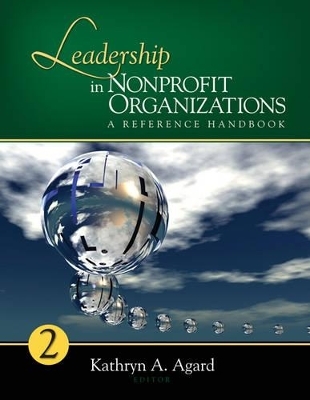
Leadership in Nonprofit Organizations
SAGE Publications Inc
978-1-4129-6886-7 (ISBN)
Leaders of nonprofit organizations deliver programs and services vital to the quality of life in the United States. All the activities of our religious communities; the vast majority of the arts and culture, human services, and community development pursuits; as well as education and environmental advocacies take root and deliver their services within the nonprofit sector.
Welcome to the world of leadership in nonprofit organizations. This sector offers an opportunity to serve as well as to lead. Leadership in Nonprofit Organizations: A Reference Handbook engages voices on issues and leadership topics important to those seeking to understand more about this dynamic sector of society. A major focus of this two-volume reference work is on the specific roles and skills required of the nonprofit leader in voluntary organizations.
Key Features
Presents contributions from a wide range of authors who reflect the variety, vibrancy, and creativity of the sector itself
Provides an overview of the history of nonprofit organizations in our country
Describes a robust and diverse assortment of organizations and opportunities for leadership
Explores the nature of leadership and its complexity as exemplified in the nonprofit sector
Includes topics such as personalities of nonprofit leaders; vision and starting a nonprofit organization; nonprofit law, statutes, taxation, and regulations; strategic management; financial management; collaboration; public relations for promoting a nonprofit organization; and human resource policies and procedures
Nonprofit organizations are a large, independent, diverse, and dynamic part of our society. This landmark Handbook tackles issues relevant to leadership in the nonprofit realm, making it a welcome addition to any academic or public library.
Kathryn Ann Agard, Ed.D., is Executive Director of the Dorothy A. Johnson Center for Philanthropy and Nonprofit Leadership at Grand Valley State University. Prior to joining the Johnson Center, Dr. Agard served for a decade as founding Executive Director of Learning to Give, an initiative of the Council of Michigan Foundations. In this role, she had management responsibility for a unique new venture to develop, test, refine, and infuse the teaching of philanthropy into the el-hi curriculum. Dr. Agard has over 30 years of nonprofit management and executive experience in health care, higher education, and foundation philanthropy. This includes creation, implementation and management of the Michigan Community Foundations' Youth Project, a $100 million program to cover the State of Michigan with community foundation service, to grow community foundations to scale, and to engage youth in grant making. Dr. Agard holds a Doctorate in Educational Leadership from Western Michigan University with a double major in public administration and human resource development. Her dissertation identified the common characteristics of community foundations to be anticipated at differing ages and asset sizes. Dr. Agard has since written and published numerous books and monographs related to organizational development and the nonprofit sector. She is Vice-President of the Board of Hackley Hospital, chairs the Investigational Review Committee, serves on the Executive and Personnel Committees, and continues as a Board member of Learning to Give. She is Lay Leader of her church and sings in the choir. Finally, Kathy is married to a retired sixth grade science teacher and has two grown children and three perfect grand-children.
Foreword
Introduction
About the Editors
About the Contributors
PART I. THE NONPROFIT AND PHILANTHROPIC SECTOR
1. Legal Definitions, Legal Accountability, and the Roles and Responsibilities of Board Leadership
2. Types of Foundations and Their Leadership Characteristics
3. Definition of Scope, Scale, and Role of the Nonprofit Sector
4. A Nonprofit Organization
5. Role of Government, Nonprofit Sector, Business, Family and Their Interaction in Democracy
6. Understanding Social Capital, Civic Engagement, and Community Building
7. Membership Associations
8. Leadership in Service Clubs and Benevolent Societies
9. Umbrella Organizations in the United States
PART II. HISTORY OF THE NONPROFIT AND PHILANTHROPIC SECTOR
10. Classic Thought Leaders Framing U.S. Philanthropy
11. Origins of the Nonprofit Sector in the United States: From the Elizabethan "Poor Laws" Through the Civil War
12. History of Nonprofit Leadership in the United States: From the Civil War to the Great Depression
13. History of Nonprofit Leadership in the United States: From the Great Depression to World War II
14. History of Nonprofit Leadership in the United States: From World War II to 1969 Tax Act
15. History of Nonprofit Leadership in the United States: From the 1969 Tax Act to the Present
16. Philanthropic Leadership in Totalitarian and Communist Countries
17. The American Presidency and Philanthropy Since the Civil War
PART III. COMMON INTEREST AREAS OF NONPROFITS AND FOUNDATIONS
18. Advocacy Organizations
19. Role of the Nonprofit Sector in Leading Innovation in Public Policy and Social Change
20. The Arts and Nonprofit Organizations
21. Community Development
22. Education (Pre-Birth, Preschool, and Early Childhood)
23. Education (K-College)
24. Environment
25. Health and Hospitals
26. Youth and Character Development
PART IV. NONPROFIT ORGANIZATIONS AND HISTORICALLY DISENFRANCHISED GROUPS
27. Gender Matters: Women Transforming Philanthropy
28. Women′s Leadership in Philanthropy
29. Role of the Nonprofit Sector in Providing Opportunities for Unpopular Causes and Disenfranchised People
30. Understanding How Philanthropy and Nonprofit Activities Manifest in Minority Communities in the United States
31. Leadership Competencies in a Diverse Culture
32. Attracting Leadership From Across Diverse Communities
33. Leadership of Philanthropy Through African American Sororities and Fraternities
PART V. LEADING THE NONPROFIT ORGANIZATION
34. Theories of Nonprofit and Organizational Leadership
35. Dynamism in Action: Leadership of the Nonprofit Enterprise
36. Progressive Leadership: Models and Perspectives for Effective Leadership
37. Basic Skills of Nonprofit Leadership
38. Roles, Responsibilities, and Characteristics of Nonprofit Leadership
39. Traditional and Unique Features of the Nonprofit CEO Role
40. Servant, Transformational, and Transactional Leadership
41. Leading Volunteers in Nonprofit Organizations
42. Policies and Procedures for Leaders: Conflict of Interest, Transparency, and Accountability
43. Transitional Leadership
44. Staff Leadership: Team-Building and Staff Development
45. Human Resource Leadership and Management
46. Tax Policy and Implications for the Organization: Tax Exemption, Charitable Deduction, and Charity Care
47. Financial Issues for Leaders
48. Fraud Awareness in Nonprofit Settings
49. Budgeting and Forecasting: Implementing Sound Strategic Financial Planning
50. Defining Fundraising Success Through Strong Donor Engagement
51. Leading the Traditional Giving Pyramid: Overview of Types and Levels of Giving
52. Grantwriting and Leadership in Working With Foundations and Government
53. Social Entrepreneurship and Business Development
54. Philanthropy and Nonprofit Leaders: Rise of the Business Model in Philanthropy
55. Selection, Functions, Structure, and Procedures of the Nonprofit Board
56. Differences in Boards Based on the Size, Age, and Type of the Organizations
57. Board and Staff Leadership Roles: Theoretical Perspectives
58. Philanthropic Leadership at the Community Level
59. Leading Nonprofit Partnerships With Government
60. What Nonprofit Leaders Should Know About Basic Economic Principles
61. When Things Go Wrong: Leadership and the Problem of Unintended Consequences
62. Leading Collaboration: Creating Strategic Alliances and Restructuring Via Mergers, Acquisitions, and Integration
63. Major Social Change Theories That Nonprofit Leaders Should Know
64. Public Policy on Tax Exemptions for Nonprofit Organizations
65. Nonprofit Organization Life Cycles
66. Role of Nonprofit Leaders in Setting the Values, Vision, and Mission of the Organization
67. Role of Nonprofit Leaders in Data and Needs Analysis and Assessment
68. Culture, Climate, and Social Context in Nonprofit Organizations
69. Marketing Issues: Who Is the Customer?
70. Role of Nonprofit Leaders in Marketing, Positioning, and Public Relations
71. Marketing Issues: Options, Types, and Targets
72. Traditional Print Vehicles and Stakeholder Groups
73. Media Relations: Promotion and Crisis Communications
74. Role of Nonprofit Leaders in Evaluation and the Use of Logic Models
75. Role of the Nonprofit Leader in Managing Risk
76. Using Data to Make Decisions
77. Challenges in Delivering Services Using New Technologies: Organizational Capacity and IT Support
78. Leading New Technology Innovation
79. Social Media and Electronic Networks
PART VI. LEADING A GRANTMAKING FOUNDATION
80. Role of the Foundation Leader in Defining Grantmaking Areas of Interest and Strategy
81. Role of the Foundation Leader in Listening to Nonprofit Organizations
82. Evaluation, Accountability, and Impact of Foundations
83. Leadership Traps for the Grantmaker: The Problem of Consistent Positive Feedback
84. Ethics and Grantmaking
PART VII. LEADERSHIP OF NONPROFITS AND THE INDIVIDUAL
85. Understanding the Charitable, Philanthropic, Altruistic Impulse
86. The Charitable Spirit: Tapping Into Altruism to Achieve the Nonprofit Mission
87. Philanthropic Motives: Who Gives and Volunteers, and Why?
88. Maintaining Personal Balance as a Leader of a Nonprofit Organization
89. Professionalization of Leadership and the Rise of Formal Management and Leadership Education
90. Nurturing the Next Generation of Philanthropic Leadership
91. Growing Your Career
PART VIII. ETHICS AND SOCIAL RESPONSIBILITY IN THE NONPROFIT WORLD
92. Fund-Raising Ethics
93. Issues in Nonprofit Ethics
94. Building an Ethic of Service
95. Cross-Cultural Management and NGO Capacity Building
96. Making the Case for Workforce Diversity
Appendix A. Books on Nonprofit Leadership
Appendix B. Print and Digital Resources in the Nonprofit and Philanthropic Sector
Appendix C. Nonprofit Websites [KA: reword title?]
Appendix D. title to come
Index
| Erscheint lt. Verlag | 30.12.2010 |
|---|---|
| Verlagsort | Thousand Oaks |
| Sprache | englisch |
| Maße | 215 x 279 mm |
| Gewicht | 3370 g |
| Themenwelt | Wirtschaft ► Betriebswirtschaft / Management ► Planung / Organisation |
| Wirtschaft ► Betriebswirtschaft / Management ► Unternehmensführung / Management | |
| ISBN-10 | 1-4129-6886-0 / 1412968860 |
| ISBN-13 | 978-1-4129-6886-7 / 9781412968867 |
| Zustand | Neuware |
| Haben Sie eine Frage zum Produkt? |
aus dem Bereich
